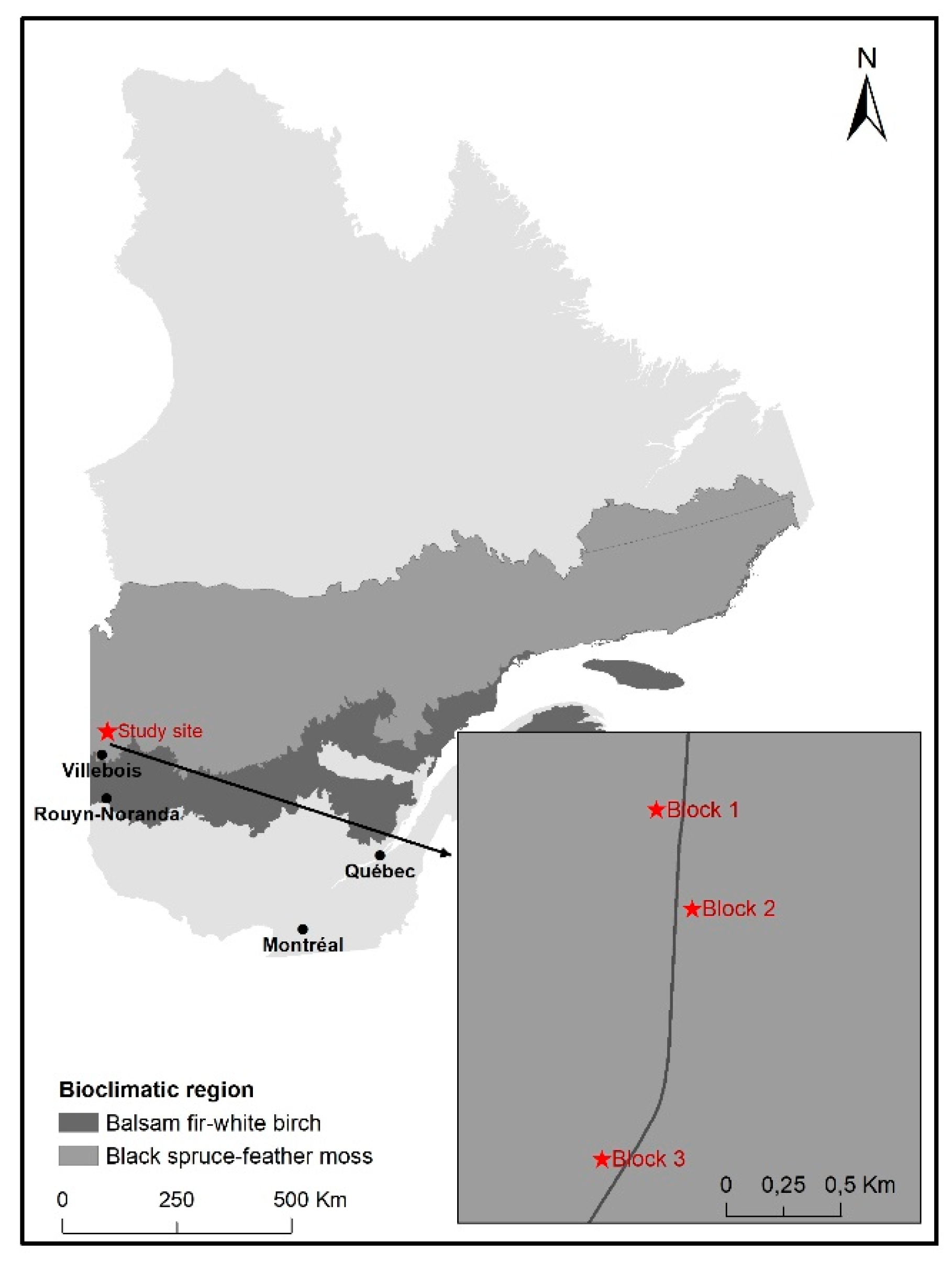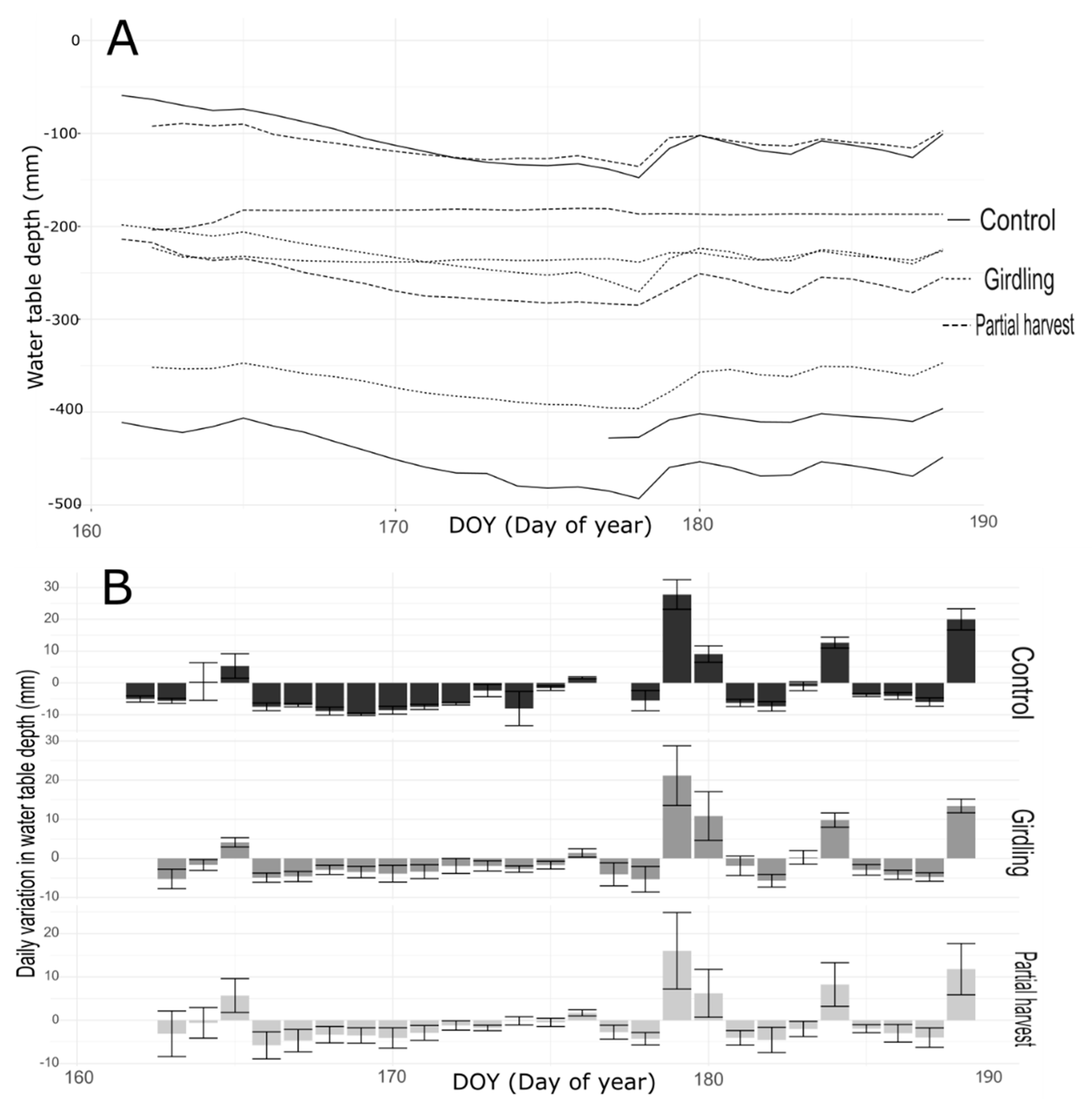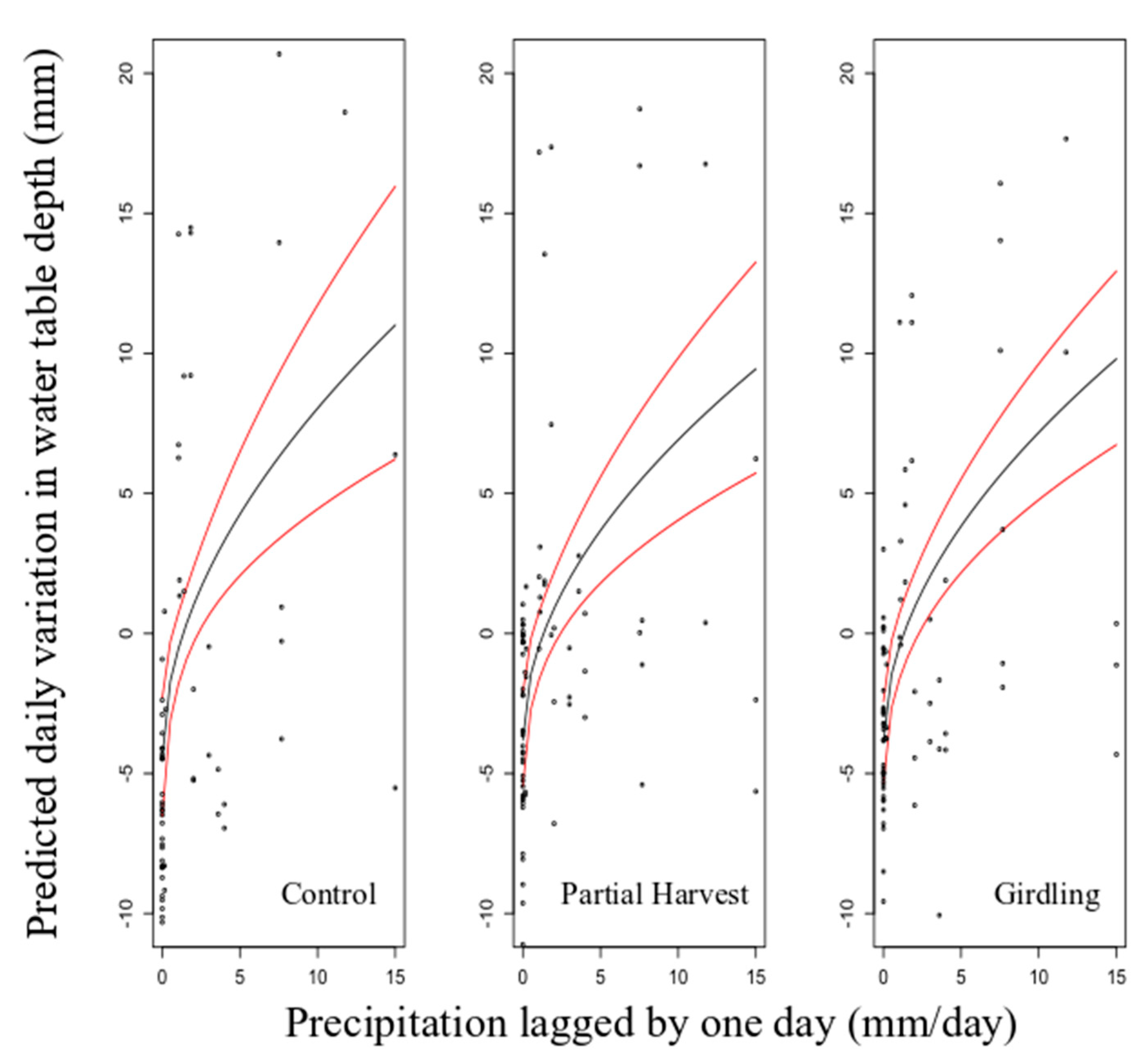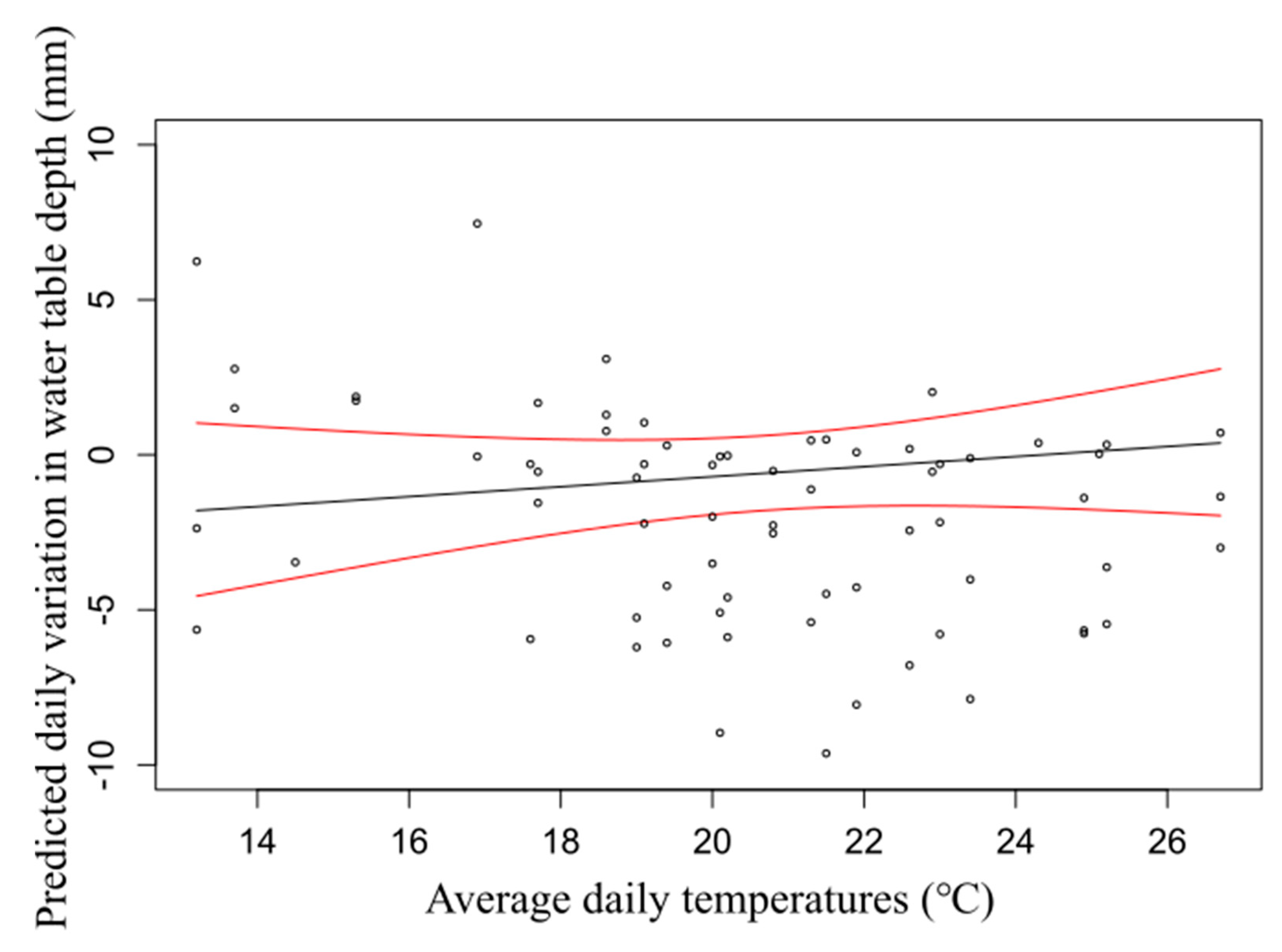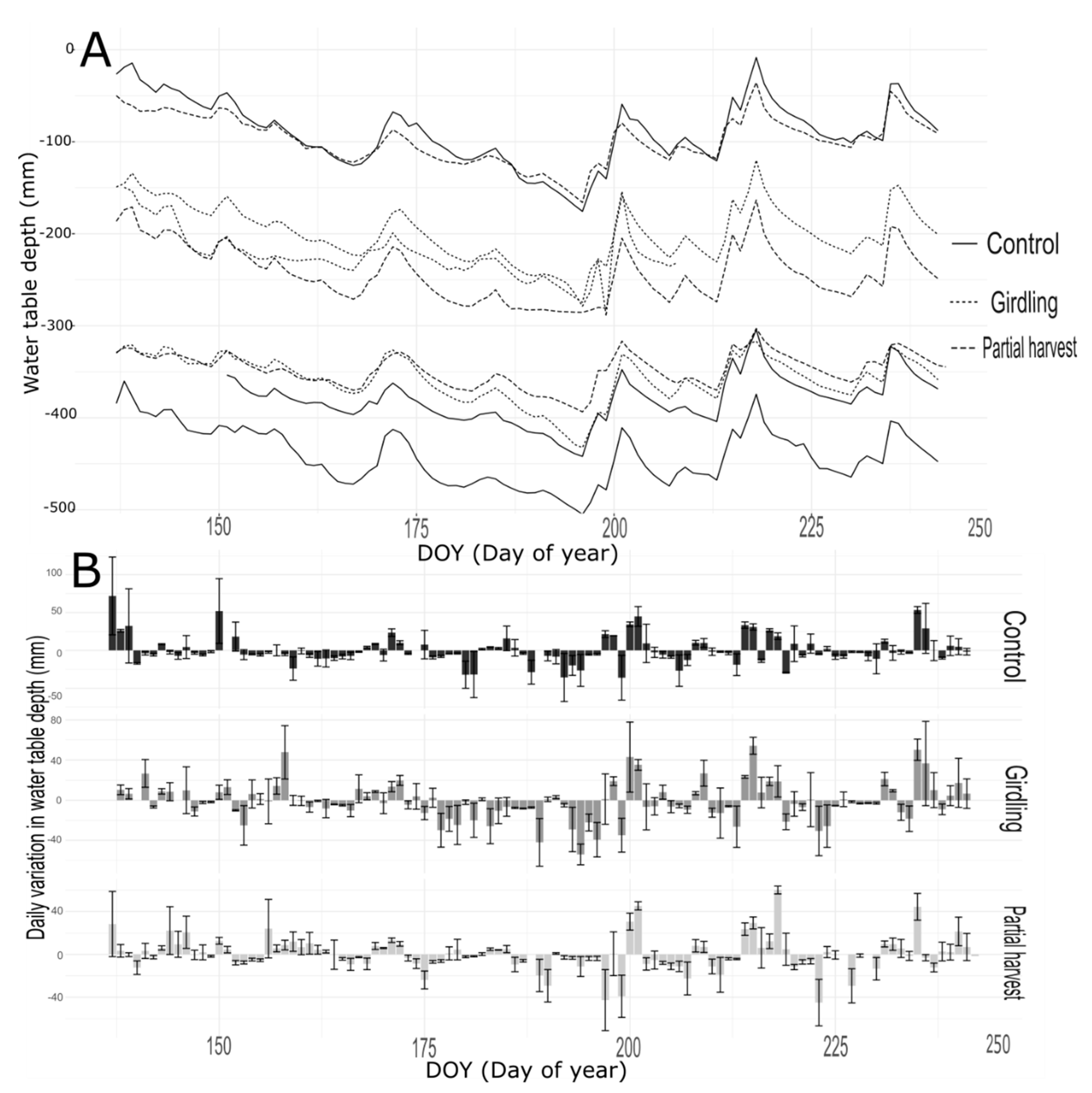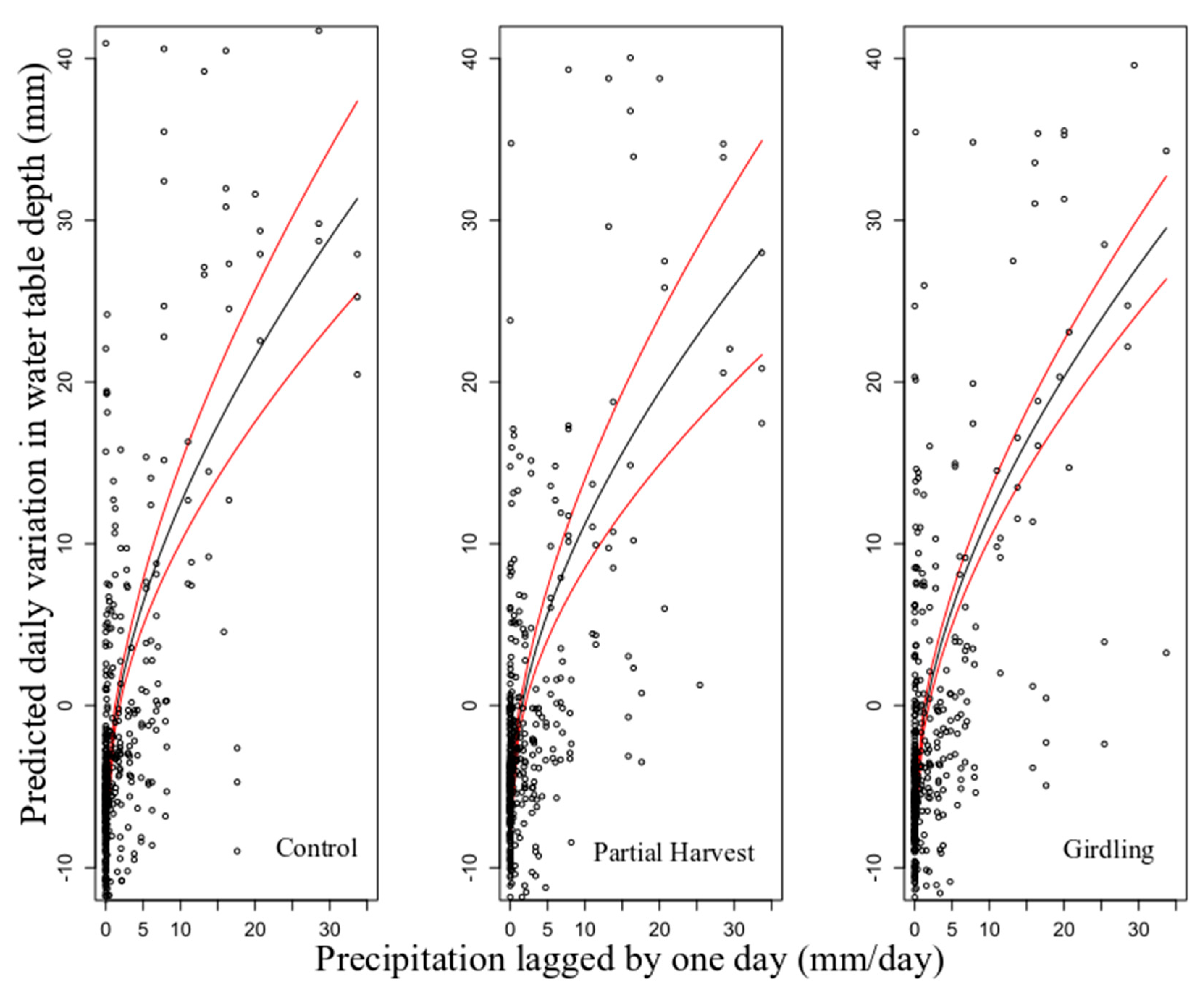Author Contributions
Conceptualization, S.J., A.L. and Y.B.; methodology, S.R.P., S.J., A.L., N.J.F. and Y.B.; software, S.R.P. and M.J.M.; formal analysis, S.R.P., S.J., A.L. and M.J.M.; data curation, S.R.P., S.J., A.L. and M.J.M.; writing—original draft preparation, S.R.P., S.J., A.L. and Y.B.; writing—review and editing, S.R.P., S.J., A.L., M.J.M., N.J.F. and Y.B.; visualization, S.R.P.; supervision, S.J., A.L. and Y.B.; project administration, S.J., A.L. and Y.B.; funding acquisition, A.L. and Y.B.; All authors have read and agreed to the published version of the manuscript.
Figure 1.
Location of the experimental plots. Each block contains one plot of each 3 treatments (control, girdling and partial harvest).
Figure 1.
Location of the experimental plots. Each block contains one plot of each 3 treatments (control, girdling and partial harvest).
Figure 2.
Water table movement throughout the growing seasons of 2016, before the sylvicultural treatments. (A) water table depth of each plot according to treatment. (B) Mean daily variation in water table depth (ΔWT) with standard error (mean ± SE) Each daily variation in water depth is a mean based on water table depth of three different plots for each treatment. The missing data for the water table depth are due to technical problems.
Figure 2.
Water table movement throughout the growing seasons of 2016, before the sylvicultural treatments. (A) water table depth of each plot according to treatment. (B) Mean daily variation in water table depth (ΔWT) with standard error (mean ± SE) Each daily variation in water depth is a mean based on water table depth of three different plots for each treatment. The missing data for the water table depth are due to technical problems.
Figure 3.
Predicted daily variation in water table depth before treatments based upon precipitation lagged by one day (mm/day) interacting with silvicultural treatment (Control, Partial harvest and Girdling). Model-averaged predictions using the entire set of candidate models are included with 95% CI. Open circles correspond to the original observations. Note that in this figure, daily variation in water table depth was back-transformed from square-root values. The figure shows the effect of variables having the greatest influence on the response variable.
Figure 3.
Predicted daily variation in water table depth before treatments based upon precipitation lagged by one day (mm/day) interacting with silvicultural treatment (Control, Partial harvest and Girdling). Model-averaged predictions using the entire set of candidate models are included with 95% CI. Open circles correspond to the original observations. Note that in this figure, daily variation in water table depth was back-transformed from square-root values. The figure shows the effect of variables having the greatest influence on the response variable.
Figure 4.
Predicted daily variation in water table depth before treatments based upon average daily temperatures (°C). Model-averaged predictions using the entire set of candidate models are included with 95% CI. Open circles correspond to the original observations. Note that in this figure, daily variation in water table depth was back-transformed from square-root values.
Figure 4.
Predicted daily variation in water table depth before treatments based upon average daily temperatures (°C). Model-averaged predictions using the entire set of candidate models are included with 95% CI. Open circles correspond to the original observations. Note that in this figure, daily variation in water table depth was back-transformed from square-root values.
Figure 5.
Water table movement throughout the growing seasons of 2017, after the sylvicultural treatments. (A) water table depth of each plot according to treatment. (B) Mean daily variation in water table depth with standard error (mean ± SE) throughout the growing seasons of 2017, after the sylvicultural treatments. Each daily variation in water depth is a mean based on water table depth of three different plots for each treatment. The missing data for the water table depth are due to technical problems.
Figure 5.
Water table movement throughout the growing seasons of 2017, after the sylvicultural treatments. (A) water table depth of each plot according to treatment. (B) Mean daily variation in water table depth with standard error (mean ± SE) throughout the growing seasons of 2017, after the sylvicultural treatments. Each daily variation in water depth is a mean based on water table depth of three different plots for each treatment. The missing data for the water table depth are due to technical problems.
Figure 6.
Predicted daily variation in water table depth following silvicultural treatments, based upon precipitation lagged by one day (mm/day) and silvicultural treatment (Control, Partial harvest and Girdling). Model-averaged predictions using the entire set of candidate models are included with 95% CI. Open circles correspond to the original observations. Note that in this figure, daily variation in water table depth was back-transformed from square-root values. The figure shows the effect of variables having the greatest influence on the response variable.
Figure 6.
Predicted daily variation in water table depth following silvicultural treatments, based upon precipitation lagged by one day (mm/day) and silvicultural treatment (Control, Partial harvest and Girdling). Model-averaged predictions using the entire set of candidate models are included with 95% CI. Open circles correspond to the original observations. Note that in this figure, daily variation in water table depth was back-transformed from square-root values. The figure shows the effect of variables having the greatest influence on the response variable.
Figure 7.
Predicted daily variation in water table depth after silvicultural treatment, based upon average daily temperatures. Model-averaged predictions using the entire set of candidate models are included in 95% CI. Open circles correspond to the original observations. Note that in this figure, daily variation in water table depth was back-transformed from square-root values. The figure shows the effect of variables having the greatest influence on the response variable.
Figure 7.
Predicted daily variation in water table depth after silvicultural treatment, based upon average daily temperatures. Model-averaged predictions using the entire set of candidate models are included in 95% CI. Open circles correspond to the original observations. Note that in this figure, daily variation in water table depth was back-transformed from square-root values. The figure shows the effect of variables having the greatest influence on the response variable.
Figure 8.
Predicted daily stem diameter variation of 45 black spruce that were sampled as a function of temperature and canopy openness (low = 21%; medium = 31%; high = 43%), interacting with precipitation during the 2017 growing season. Model-averaged predictions using the entire set of candidate models are included with 95% CI. Open circles correspond to the original observations. Note that in this figure, diameters were back-transformed from the logarithmic scale. The figure shows the effect of variables having the greatest influence on the response variable.
Figure 8.
Predicted daily stem diameter variation of 45 black spruce that were sampled as a function of temperature and canopy openness (low = 21%; medium = 31%; high = 43%), interacting with precipitation during the 2017 growing season. Model-averaged predictions using the entire set of candidate models are included with 95% CI. Open circles correspond to the original observations. Note that in this figure, diameters were back-transformed from the logarithmic scale. The figure shows the effect of variables having the greatest influence on the response variable.
Table 1.
Merchantable basal area and the number of stems ha−1 (mean ± SD) per plot, before and after application of treatments, together with mean organic matter depth.
Table 1.
Merchantable basal area and the number of stems ha−1 (mean ± SD) per plot, before and after application of treatments, together with mean organic matter depth.
| | Partial Harvest | Girdling | Control |
|---|
| Number of plots per treatment | 3 | 3 | 3 |
| Canopy openness before treatment (%) | 33.7 ± 5.2 | 34.8 ± 6.8 | 27.8 ± 7.2 |
| Canopy openness after treatment (%) | 34.4 ± 5 | 34.9 ± 6.3 | 27.7 ± 7.0 |
| Basal area before treatment (m2/ha) | 16.1 ± 6.7 | 14.8 ± 8.0 | 15.6 ± 7.8 |
| Basal area after treatment (m2/ha) | 10.1 ± 4.1 | 8.8 ± 4.7 | 15.6 ± 7.8 |
| Proportion of affected basal area (%) | 37.1 ± 0.7 | 40.7 ± 1.8 | 0 |
| Stems ha−1 before treatment | 2408 ± 181 | 1891 ± 440 | 2125 ± 328 |
| Stems ha−1after treatment | 2192 ± 231 | 1891 ± 440 | 2125 ± 328 |
| Mean organic matter depth (cm) | 59.3 ± 16.4 | 61.3 ± 20.2 | 52.3 ± 13.3 |
Table 2.
Subdivision of bryophytes in three categories: mosses and lichens, hummock sphagna, and plateau sphagna.
Table 2.
Subdivision of bryophytes in three categories: mosses and lichens, hummock sphagna, and plateau sphagna.
| Mosses and Lichens | Hummock Sphagna | Plateau Sphagna |
|---|
| Pleurozium schreberi | Sphagnum capillifolium | Sphagnum wulfianum |
| Ptilidium ciliare | Sphagnum russowii | Sphagnum angustifolium |
| Ptilium crista-castrensis | Sphagnum fuscum | Sphagnum divinum or Sphagnum medium |
| Hylocomium splendens | | |
| Cladonia rangiferina | | |
| Cladonia stellaris | | |
Table 3.
List of candidate models explaining daily variation of water table depth between consecutive days (ΔWT) before and after treatments in 2016 and 2017, during the growing season (May to September). Each model type is based upon either stand characteristics or silvicultural treatment effects. Candidate variables included temperature (TEMP), canopy openness (CANOP), standardized precipitation that was lagged by one day (PRECL), stem ha−1 (STEM), silvicultural treatments (TREAT) with three different levels (control, partial harvest, girdling), basal area (BASAL), and water table depths (WTD). The third column is the expected effect on ΔWT, the hypotheses tested and the associated references.
Table 3.
List of candidate models explaining daily variation of water table depth between consecutive days (ΔWT) before and after treatments in 2016 and 2017, during the growing season (May to September). Each model type is based upon either stand characteristics or silvicultural treatment effects. Candidate variables included temperature (TEMP), canopy openness (CANOP), standardized precipitation that was lagged by one day (PRECL), stem ha−1 (STEM), silvicultural treatments (TREAT) with three different levels (control, partial harvest, girdling), basal area (BASAL), and water table depths (WTD). The third column is the expected effect on ΔWT, the hypotheses tested and the associated references.
| Model Type | Candidate Models | Expected Effect and Hypotheses Tested |
|---|
| Stand characteristics models | ΔWT ~ STEM + PRECL + TEMP + CANOP | Negative effect of high stem density and high temperature. Positive effect of precipitation and greater canopy openness [27]. |
| ΔWT ~ PRECL + TEMP + CANOP +CANOP: TEMP | Interaction between temperature and canopy openness. Positive effect of precipitation [43]. |
| ΔWT ~ TEMP+ PRECL+CANOP+ PRECL: CANOP | Negative effect of high temperature. Interaction between precipitation and canopy openness [43]. |
| ΔWT ~ TEMP + PRECL+ CANOP +STEM+ CANOP: PRECL +CANOP: TEMP | Most complex stand characteristics model. |
| Silvicultural models | ΔWT ~ TREAT + PRECL + WTD | Positive effect of precipitation. Differences among treatments [23,24,26,52]. H1, H2, H3 |
| ΔWT ~ WTD + PRECL + WTD: PRECL | Different effect of precipitation following water table depth [23,24,26,52]. |
| ΔWT ~ BASAL + TREAT + BASAL: TREAT | Different effect among treatments following basal area [23,24,26,52]. H1, H2, H3 |
| ΔWT ~ WTD + TREAT + PRECL TREAT: PRECL | Effect of the water table depth. Different effect of precipitation among treatments [23,24,26,52]. H1, H2, H3 |
| ΔWT ~ WTD + TREAT + PRECL + BASAL + TREAT: PRECL + TREAT: BASAL + WTD: PRECL | Most complex silvicultural model. |
| ΔWT ~ 1 | Null model. |
Table 4.
List of candidate models explaining daily stem diameter variation (SDV) of black spruce during the 2017 growing season. Variable selection was based upon effects of silvicultural treatments and stand characteristics: silvicultural treatments (TREAT) with three different levels (control, partial harvest, girdling); precipitation (PREC); standardized water table depths (WTD); temperature (TEMP); canopy openness (CANOP); organic matter depths (OMD); and feather moss and sphagnum (FEA, SPH). The third column includes the expected effect, the hypotheses tested and the associated references.
Table 4.
List of candidate models explaining daily stem diameter variation (SDV) of black spruce during the 2017 growing season. Variable selection was based upon effects of silvicultural treatments and stand characteristics: silvicultural treatments (TREAT) with three different levels (control, partial harvest, girdling); precipitation (PREC); standardized water table depths (WTD); temperature (TEMP); canopy openness (CANOP); organic matter depths (OMD); and feather moss and sphagnum (FEA, SPH). The third column includes the expected effect, the hypotheses tested and the associated references.
| Model Type | Candidate Models | Expected Effect and Hypotheses Tested |
|---|
| Silvicultural models | SDV ~ WTD + PREC + TREAT | Negative effect of water table depth and precipitation. Differences among treatments [20,21,29], H4 |
| SDV ~ WTD + TREAT + PREC + TREAT: PREC | Negative effect of water table depth. Different effects of precipitation among treatments [20,21,29], H4 |
| SDV ~ PREC + TREAT + WTD +TREAT: WTD | Negative effect of precipitation. Different effect of water table depth according to the treatments [20,21,29], H4 |
| SDV ~ WTD + PREC + TREAT+ TREAT: PREC + TREAT: WTD | Most complex silvicultural model. |
| Stand characteristics models | SDV ~ OMD + PREC + CANOP + TEMP + WTD | Negative effect of precipitation, organic matter depth and high water table. Positive effect of high temperature and low canopy openness [14,19,20,21,29], H4 |
| SDV ~ WTD + FEA + SPH + OMD | Negative effect of water table depth, hummock sphagnum and organic matter depth. Positive effect of large feather moss coverage [19,20,43], H4 |
| SDV ~ TEMP + CANOP + PREC + CANOP: PREC | Positive effect of high temperature, different effect of precipitation following canopy openness [20,29] |
| SDV ~ TEMP + CANOP + PREC | Positive effect of high temperature and low canopy openness. Negative effect of precipitation [20,29]. |
| SDV ~ OMD + TEMP + CANOP + PREC+WTD + FEA + SPH + CANOP: PREC | Most complex stand characteristics model. |
| SDV ~ 1 | Null model. |
Table 5.
Most parsimonious models of silvicultural treatment and stand characteristic explaining daily variation in water table depth (ΔWT) before treatments, including the number of parameters (K), difference in AICc compared to the highest-ranked model (ΔAICc), AICc model weight (AICcWt), and predictive power (marginal R2). Parameters appearing in the second portion of the table show the variables for which 95% confidence intervals exclude 0 and that influenced the response variable. The count of parameters includes the variance associated with the random-block effect, the treatment within-random-block effect and the residual variance. Note that girdling was the reference level of the treatment variable.
Table 5.
Most parsimonious models of silvicultural treatment and stand characteristic explaining daily variation in water table depth (ΔWT) before treatments, including the number of parameters (K), difference in AICc compared to the highest-ranked model (ΔAICc), AICc model weight (AICcWt), and predictive power (marginal R2). Parameters appearing in the second portion of the table show the variables for which 95% confidence intervals exclude 0 and that influenced the response variable. The count of parameters includes the variance associated with the random-block effect, the treatment within-random-block effect and the residual variance. Note that girdling was the reference level of the treatment variable.
| Candidate Models | K | ΔAICc | AICcWt | R2 | Residual Variance |
| ΔWT ~ TEMP + PRECL + CANOP + PRECL: CANOP | 9 | 0.00 | 0.21 | 0.30 | 0.173 |
| ΔWT ~ WTD + TREAT + PRECL + TREAT: PRECL | 11 | 0.10 | 0.20 | 0.31 | 0.171 |
| Parameters | Lower 95% CL | Model-averaged estimate (β) | Upper 95% CL |
| Temperature (TEMP) | 0.001 | 0.02 | 0.03 |
| Precipitation lagged by one day (PRECL) | 0.18 | 0.23 | 0.27 |
| Treatment (Control): Precipitation (PRECL) | 0.02 | 0.13 | 0.25 |
Table 6.
Most parsimonious models of silvicultural treatment and stand characteristic explaining daily variation in water table depth (ΔWT) after treatment, including the number of parameters (K), difference in AICc compared to highest-rankedmodel (ΔAICc), AICc model weight (AICcWt), and predictive power (marginal R2). Parameters appearing in the second portion show the variables for which 95% confidence intervals exclude 0 and that influenced the response variable. The count of parameters includes the variance associated with the block random effect, the treatment within block random effect and the residual variance. Note that girdling was the reference level of the treatment variable.
Table 6.
Most parsimonious models of silvicultural treatment and stand characteristic explaining daily variation in water table depth (ΔWT) after treatment, including the number of parameters (K), difference in AICc compared to highest-rankedmodel (ΔAICc), AICc model weight (AICcWt), and predictive power (marginal R2). Parameters appearing in the second portion show the variables for which 95% confidence intervals exclude 0 and that influenced the response variable. The count of parameters includes the variance associated with the block random effect, the treatment within block random effect and the residual variance. Note that girdling was the reference level of the treatment variable.
| Candidate Models | K | ΔAICc | AICcWt | R2 | Residual Variance |
| ΔWT ~ PRECL + CANOP + TEMP + CANOP: TEMP | 9 | 0.00 | 0.25 | 0.41 | 0.416 |
| ΔWT ~ WTD + PRECL + TREAT + WTD: PRECL + TREAT: PRECL | 12 | 0.28 | 0.22 | 0.41 | 0.417 |
| Parameters | Lower 95% CL | Model-averaged estimate (β) | Upper 95% CL |
| Temperature (TEMP) | 0.02 | 0.03 | 0.04 |
| Precipitation lagged by one day (PRECL) | 0.35 | 0.37 | 0.40 |
| Treatment (Control): Precipitation (PRECL) | 2.2 × 10−2 | 8.4 × 10−2 | 1.4 × 10−1 |
Table 7.
Most parsimonious model explaining daily variation of stem diameter (SDV) with the number of parameters (K), difference in AICc compared to highest-ranked model (ΔAICc), AICc model weight (AICcWt) and the predictive power (marginal R2). Parameters appearing in the second portion of the table show variables for which 95% confidence intervals exclude 0 and that influenced the response variable. Note that the count of parameters includes the variance associated with the random-block effect, the treatment within-random-block effect and the residual variance.
Table 7.
Most parsimonious model explaining daily variation of stem diameter (SDV) with the number of parameters (K), difference in AICc compared to highest-ranked model (ΔAICc), AICc model weight (AICcWt) and the predictive power (marginal R2). Parameters appearing in the second portion of the table show variables for which 95% confidence intervals exclude 0 and that influenced the response variable. Note that the count of parameters includes the variance associated with the random-block effect, the treatment within-random-block effect and the residual variance.
| Candidate Models | K | ΔAICc | AICcWt | R2 | Residual Variance |
| SDV ~ TEMP + CANOP + PREC + CANOP: PREC | 8 | 0.00 | 0.95 | 0.23 | 0.416 |
| Parameters | Lower 95% CL | Model-averaged estimate (β) | Upper 95% CL |
| Temperature (TEMP) | 8.37 × 10−3 | 1.09 × 10−2 | 1.34 × 10−2 |
| Canopy openness (CANOP): Precipitation (PREC) | 1.81 × 10−3 | 2.51 × 10−3 | 3.20 × 10−3 |
